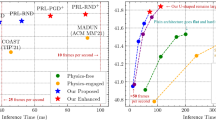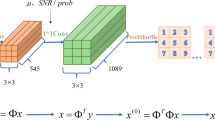Abstract
Image compressed sensing technology, particularly algorithm unrolling networks, has garnered significant attention in the field of compressed sensing due to their interpretability and high performance. However, similar to traditional compressed sensing methods, algorithm unrolling networks update and transmit pixel-level image data through specific instances of algorithms, often failing to fully exploit the rich information encoded in image features. This limitation results in information loss and incomplete feature fusion. In this paper, we introduce a novel approach: the Generalized Structure Iterative Shrinkage Threshold Algorithm (GSISTA), and present an algorithm extension network built upon GSISTA, referred to as GSISTA-Net. GSISTA-Net facilitates the efficient transfer of image feature information during the deep reconstruction stage through a jump connection structure. Additionally, it incorporates a dual-scale denoising module within the deep reconstruction stage to enhance denoising effectiveness. Our experimental results demonstrate that the proposed method surpasses the performance of five prominent state-of-the-art algorithms, specifically ReconNet, CSNet, ISTA-Net\(^+\), AMPNet, and OPINE-Net\(^+\), when evaluated in terms of both Peak Signal-to-Noise Ratio (PSNR) and Structural Similarity Index (SSIM).




Similar content being viewed by others
Data Availability
Data will be made available on reasonable request.
References
Tsaig Y, Donoho DL (2006) Extensions of compressed sensing. Signal Process 86(3):549–571
Marques EC, Maciel N, Naviner L (2019) Deep learning approaches for sparse recovery in compressive sensing. In: 2019 11th International symposium on image and signal processing and analysis (ISPA), pp 129–134
Zeng C, **a S, Wang Z, Wan X (2023) Multi-channel representation learning enhanced unfolding multi-scale compressed sensing network for high quality image reconstruction. Entropy 25(12):1579. https://doi.org/10.3390/e25121579
Cui W, Liu S, Jiang F (2021) Image compressed sensing using non-local neural network. In: IEEE Transactions on multimedia, pp 1–14
Shi W, Jiang F, Liu S (2019) Scalable convolutional neural network for image compressed sensing. In: 2019 IEEE/CVF conference on computer vision and pattern recognition (CVPR), pp 12282–12291
Mousavi A, Patel AB, Baraniuk RG (2015) A deep learning approach to structured signal recovery. In: 2015 53rd Annual allerton conference on communication, control, and computing (Allerton), pp 1336–1343
Mousavi A, Baraniuk RG (2017) Learning to invert: signal recovery via deep convolutional networks. In: International conference on acoustics, speech and signal processing, pp 2272–2276
Yao H, Da F, Zhang D (2019) DR2-Net : deep residual reconstruction network for image compressive sensing, pp 483–493
Zeng C, Ye J, Wang Z, Zhao N, Wu M (2022) Cascade neural network-based joint sampling and reconstruction for image compressed sensing. Signal, Image and Video Processing 16(1):47–54
Wang Z, Wang Z, Zeng C, Yu Y, Wan X (2022) High-Quality Image Compressed Sensing and Reconstruction with Multi-scale Dilated Convolutional Neural Network. Circuits, Systems, and Signal Processing, pp 1–24
Kulkarni K, Lohit S, Turaga P (2016) ReconNet: non-iterative reconstruction of images from compressively sensed measurements. In: 2016 IEEE Conference on computer vision and pattern recognition (CVPR), pp 449–458
Shi W, Jiang F, Liu S (2018) Multi-scale deep networks for image compressed sensing. In: 25th IEEE International conference on image processing (ICIP), pp 46–50
Suhas Lohit, Kuldeep Kulkarni, Ronan Kerviche, Pavan Turaga, Amit Ashok (2018) Convolutional neural networks for noniterative reconstruction of compressively sensed images. IEEE Trans Comput Imaging 4(3):326–340
Zhou S, He Y, Liu Y, Li C, Zhang J (2020) Multi-channel deep networks for block-based image compressive sensing. IEEE Trans Multimedia 23:2627–2640
Dhengre N, Sinha SK (2022) sparse autoencoder-based accelerated reconstruction of magnetic resonance imaging. Vis Comput 38:837–847
Suhas Lohit, Kuldeep Kulkarni, Ronan Kerviche, Pavan Turaga, Amit Ashok (2018) Convolutional neural networks for noniterative reconstruction of compressively sensed images. IEEE Trans Comput Imaging 4(3):326–340
Shi W, Jiang F, Liu S, Zhao D (2017) Deep networks for compressed image sensing. In: Proceedings of the 2017 IEEE international conference on multimedia and expo (ICME), pp 877–882
Gunning D, Aha DW (2019) Darpa’s explainable artificial intelligence program. Magazine 40(2):44–58
Li L, Wang Z, Zhang T (2023) Gbh-yolov5: Ghost convolution with bottleneckcsp and tiny target prediction head incorporating yolov5 for pv panel defect detection. Electronics 12(3):1–15. https://doi.org/10.3390/electronics12030561
Wang Z, Li L, Zeng C, Yao J (2023) Student learning behavior recognition incorporating data augmentation with learning feature representation in smart classrooms. Sensors 23(19):8190. https://doi.org/10.3390/s23198190
Zeng C, Yan K, Wang Z, Yu Y, **a S, Zhao N (2023) Abs-cam: A gradient optimization interpretable approach for explanation of convolutional neural networks. Signal, Image and Video Processing 17(4):1069–1076. https://doi.org/10.1007/s11760-022-02313-0
Monga V, Li Y, Eldar YC (2021) Algorithm unrolling: interpretable, efficient deep learning for signal and image processing. IEEE Signal Processing Magazine 38(2):18–44
Gregor K, Lecun Y (2010) Learning fast approximations of sparse coding. In: The 27th International conference on international conference on mechine learning(ICML), pp 399–406
Daubechies I, Defrise M, Mol CD (2004) An iterative thresholding algorithm for linear inverse problems with a sparsity constraint. Commun 57(11):1413–1457
Zhang J, Ghanem B (2018) ISTA-Net: interpretable optimization-inspired deep network for image compressive sensing. In: 2018 IEEE/CVF conference on computer vision and pattern recognition, pp 1828–1837
Zhang J, Zhao C, Gao W (2020) Optimization-inspired compact deep compressive sensing. IEEE J Sel Top Signal Process 14(4):765–774
Erseghe T, Zennaro D (2011) Fast consensus by the alternating direction multipliers method. IEEE Trans Signal Process 59(11):5523–5537
Yang Y, Sun J, Li H, Xu Z (2020) ADMM-CSNet: a deep learning approach for image compressive sensing. IEEE Trans Pattern Anal Mach Intell 42(3):521–538
Pei H, Yang C, Wei Z (2021) Image compression-aware reconfiguration neural network based on SPL iterative idea. J Electron 49(06):1195–1203
Donoho DL, Maleki A, Montanari A (2009) Message-passing algorithms for compressed sensing. Proc Natl Acad Sci 106(45):18914–18919
Zhang Z, Liu Y, Liu J (2021) AMP-Net: denoising based deep unfolding for compressive image sensing. IEEE Trans Image Process 30:1487–1500
Donoho DL (2006) Compressed sensing. IEEE Trans Inf Theory 52(4):1289–1306
Beck A, Teboulle M (2009) A fast iterative shrinkage thresholding algorithm for linear inverse problems. SIAM J Imaging Sci 2(1):183–202
Martin D, Fowlkes C, Tal D (2001) A database of human segmented natural images and its application to evaluating segmentation algorithms and measuring ecological statistics. In: Proc. IEEE Int. Conf.Comput. Vision, pp 416-423
Wang Z, Bovik AC, Sheikh HR, Simoncelli EP (2004) Image quality assessment: from error visibility to structural similarity. IEEE Trans Image Process 13(4):600–612
Acknowledgements
The research work of this paper were supported by the National Natural Science Foundation of China (No. 62177022, 61901165, 61501199), Natural Science Foundation of Hubei Province (No. 2022CFA007), Collaborative Innovation Center for Informatization and Balanced Development of K-12 Education by MOE and Hubei Province (No. xtzd2021-005), and Wuhan Knowledge Innovation Project (No.2022020801010258).
Author information
Authors and Affiliations
Corresponding author
Ethics declarations
Conflicts of interest
No potential conflict of interest was reported by the authors.
Additional information
Publisher's Note
Springer Nature remains neutral with regard to jurisdictional claims in published maps and institutional affiliations.
Rights and permissions
Springer Nature or its licensor (e.g. a society or other partner) holds exclusive rights to this article under a publishing agreement with the author(s) or other rightsholder(s); author self-archiving of the accepted manuscript version of this article is solely governed by the terms of such publishing agreement and applicable law.
About this article
Cite this article
Zeng, C., Yu, Y., Wang, Z. et al. GSISTA-Net: generalized structure ISTA networks for image compressed sensing based on optimized unrolling algorithm. Multimed Tools Appl (2024). https://doi.org/10.1007/s11042-024-18724-9
Received:
Revised:
Accepted:
Published:
DOI: https://doi.org/10.1007/s11042-024-18724-9




